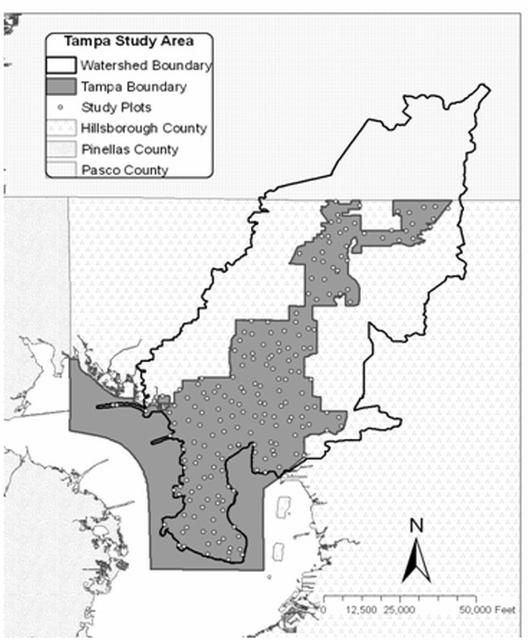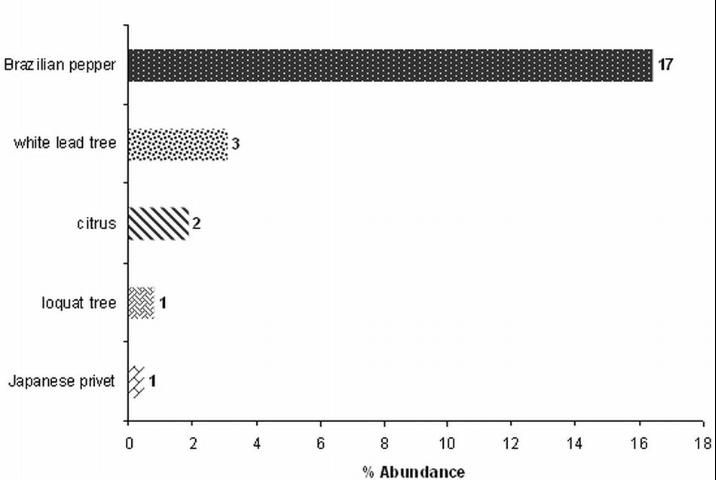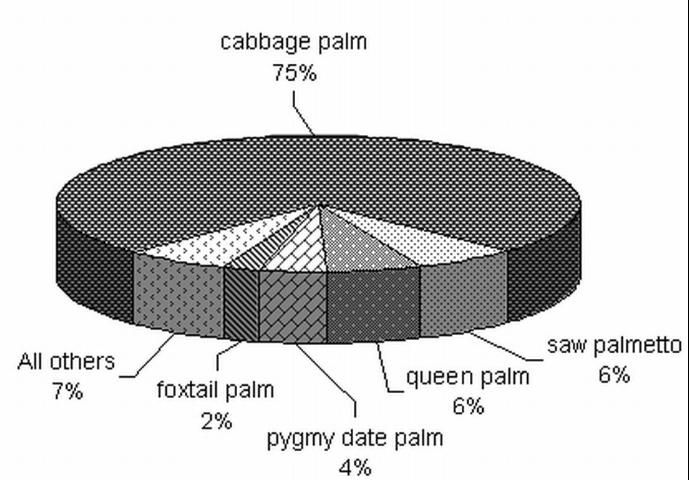A Brief Overview of Tampa's Urban Ecological Assessment
What Is the Purpose of an Urban Ecological Assessment?
The purpose of an urban ecological assessment is to provide a detailed look into the economic and ecological characteristics and values of the urban forest. The results from this type of assessment can serve as the basis for: 1) enhancing the understanding of urban forest values, 2) improving or developing urban forest policies, 3) ensuring effective planning and management of the urban landscape and, 4) providing data for the inclusion of trees within environmental regulations.
From February to July, 2007 an urban ecological assessment was conducted in the city of Tampa. A total of 201 permanent sample plots were located within Tampa's city limits (Figure 1). These plots will be revisited every 5 years in an effort to monitor changes in Tampa's urban forest structure and assess how these changes are related to the functions the forest provides.

Credit:
The team used the Urban Forest Effects (UFORE) model developed by the USDA Forest Service to calculate values for variables such as: tree diversity; species origin; abundance; tree density; size distribution; tree, shrub and surface covers; and leaf area by land use. The model also quantifies urban forest functions such as: energy saving, air pollution removal, carbon storage and sequestration, and compensatory or replacement values.
Native and Non-Native (Exotic) Species
What Is the Difference between Native and Non-native Species?
Native species are defined as those that were found in Florida before Europeans colonized the region in the 16th century. Non-native species occur outside of their native range and have been introduced to Florida by humans, either intentionally as crops, ornamentals, etc. or by accidental transport via boats, trains, and automobiles (Langland and Burks 1998).
What Is an Invasive Species?
Some of the tree and plant species in Tampa are also classified as "invasive." Invasive species are able to spread into and dominate an area in part due to a lack of natural predators and/or diseases. Invasive species tend to be non-native but can also be native. Regardless, invasive species are considered "invasive" because they negatively impact the ecological functions of the forest by reducing species diversity. Species diversity is important for maintaining the resilience of the urban forest, especially when considering natural disturbances and the forest's ability to provide ecosystem services such as nutrient cycling, air pollution reduction, carbon sequestration, and wildlife habitat.
Does Tampa's Urban Forest have Non-native and Invasive Tree Species?
Of the 93 tree species found in Tampa, 76% are native to North America and the remaining 24% are non-native. Of those native to North America, approximately 50% are considered to be native to Florida. Perhaps of greater concern is that one of the most common tree species in Tampa, Brazilian pepper (Schinus terebinthifolius) (Figure 2), is both non-native and invasive. It readily spreads into disturbed areas such as fields, ditches, along canals, and in flatwood forests, growing in thickets that are costly to eradicate. The dominance of this species is not confined to Tampa; in fact, it is estimated to be established on over 1 million acres throughout the state (Langeland and Burks 1998).

Credit:
Palms in the Urban Forest
Are Palm Trees Really Trees?
Palms are monocots or grass-like plants. Some can grow tall and have large stems like trees. While not truly trees, they perform many of the same functions as trees, such as providing cover, removing air pollution, and storing and sequestering carbon.
How Many Palms are in Tampa?
In 2007, the total number of palms in Tampa was estimated to be 584,660. Palms represent approximately 7% of the trees in Tampa's urban forest.
What Is the Most Common Palm?
The Florida state tree is the native cabbage palm (Sabal palmetto) and it is the most abundant palm in Tampa, accounting for 6% of the urban forest. Cabbage palm is one of the top ten dominant tree species found in the urban forest and accounts for 75% of all palms in Tampa (Figure 3). Cabbage palms are tolerant of both drought and high water tables, and therefore can exist across a broad spectrum of growing conditions. Within the urban environment it is found in parks and other natural areas. The cabbage palm's high level of wind resistance also makes it an ideal palm for planting near buildings and in public areas (Duryea 2006).
What Other Native Palm Species are in the Urban Forest?
Saw palmetto (Serenoa repens) is the second most common palm in the city and is native to Florida. It is naturally drought and insect resistant, and is commonly seen in less urbanized forested areas as the thick, palm ground cover beneath open pine woodlands.
In addition to these native palms, many non-native palms provide a distinct aesthetic element to the city’s landscape, and palm species have been consistently used on residential sites and public rights-of-way to accent the city's sub-tropical climate.
What Diseases Affect Palms in Tampa?
One disease affecting palms in Tampa is Fusarium oxysporum, a fatal fungal disease. This disease affects queen palm (Syagrus romanozoffiana), the third most common palm in the city (6%), and Mexican fan palm (Washingtonia robusta), another of the more common (2%), large stature palms. Researchers now suggest that the disease is likely being spread by wind and that palms should not be replanted onto a site where a palm with this disease was removed previously (Andreu et al. 2008). Another disease affecting palms in Tampa is the Texas Phoenix palm decline, a fatal bacterial disease. This disease affects Canary Island date palm (Phoenix canariensis), edible date palm (Phoenix dactylifera), wild date palm (Phoenix sylvestris) and cabbage palm.

Credit:
Mangroves in the Urban Forest
What are Mangrove Forests?
In the continental United States, the natural range of mangrove forests is limited to the Southeast. This is because mangrove trees are sensitive to sub-freezing temperatures. They can be found on the coasts of North and South Carolina, Georgia, Florida, Alabama, Mississippi, Louisiana, and Texas (Odum and McIvor 1990). Approximately 50 percent of the trees in Tampa's urban forest are mangrove trees. However, mangroves are small-diameter trees that tend to grow in dense thickets and are confined to areas along the coast. As a result, they are greatly represented in number but occupy a small area compared to other species in Tampa's urban forest.
Are There Different Types of Mangrove Trees?
The mangrove forest of Tampa includes three tree species; red (Rhizophora mangle), black (Avicennia germinans) and white (Laguncularia racemosa) mangrove. These three types are found in distinct but overlapping ecological zones along the coastline. Red mangroves are the most common (84%) followed by black (11%) and white (5%) mangroves.
Why are Mangrove Forests Important?
The mangrove forest is valued for its ability to filter pollution, stabilize sediments and protect the shoreline from erosion. Mangrove forests are an integral part of the ecological functionality of the Tampa Bay estuary because they provide food, nesting and nursery areas for a great variety of fish, shellfish, birds and other wildlife. Mangrove forests also provide habitat for many of Florida's threatened and endangered species of plants and animals.
What Is the Economic Value of These Mangrove Forests?
The mangrove forest contributes an estimated $220 million or 15% of the compensatory (replacement) value of Tampa's urban forest. This does not account for the economic value of the sport and commercial fishing industries or the value of the ecological services mangroves provide such as nutrient cycling, erosion control, wildlife habitat, etc. Mangrove forests also help protect inland areas from storm surges during tropical storms and hurricanes.
Are There Regulations Involving Mangroves?
Mangrove trimming and alteration are regulated through Florida's "Mangrove Trimming and Preservation Act" as amended by the 1999 Florida Legislature. The intent of the legislation is to protect valuable mangrove resources from unregulated removal, defoliation, or destruction. This legislation ensures that the mangrove forests are managed in a sustainable manner while protecting the rights of property owners.
The content of this fact sheet was derived from the "City of Tampa: Urban Ecological Analysis" and the full report can be viewed by visiting http://www.sfrc.ufl.edu/urbanforestry/Files/TampaUEA2006-7_FinalReport.pdf
References
Andreu, M. G., M. H. Friedman, S. M. Landry, and R. J. Northrop. 2008. City of Tampa Urban Ecological Analysis 2006-2007. Final Report to the City of Tampa, April 24, 2008. City of Tampa, Florida.
Duryea, M. L. 2006. Wind and Trees: Surveys of Tree Damage in the Florida Panhandle after Hurricanes Erin and Opal. University of Florida Cooperative Extension Service – Circular 1183.
Langeland, K. A. and K. C. Burks. 1998. Identification and Biology of Non-Native Plants in Florida's Natural Areas. Gainesville, University of Florida.
Mangrove Trimming and Preservation Act of 1999, Florida State Law, Chapter 403 Section 9321-9333.
Odum, W. E. and C. C. McIvor. 1990. Mangroves in Ecosystems of Florida. R. L. Myers and J. J. Ewel. Orlando, University of Central Florida Press.